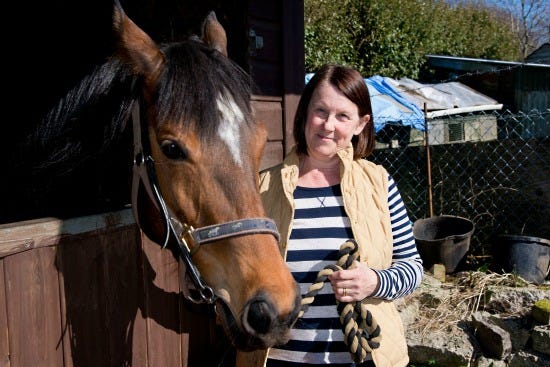Dark Horse: The Incredible True Story of Dream Alliance

Falling firmly into the "fairy tales do come true" category of documentary filmmaking, "Dark Horse: The Incredible True Story of Dream Alliance" shares the story of a bunch of working-class folks in Cefn Fforest, a small former mining town in South Wales, who decided to pool their meager resources to breed a thoroughbred race horse and chase glory.
Director Louise Osmond combines gorgeous photography, revealing interviews and archival footage (with some reenactments) to chronicle their amazing tale. It's an uplifting story, told with skill and empathy.
Jan Volkes stands astride the middle of the story, a humble barmaid and store cleaner who overheard some chaps in the men's club chatting about horse racing. One of them, a tax advisor named Howard Davies, had lost 5,000 pounds a few years earlier dabbling in the exclusive hobby of the rich and titled.
Never again, he vowed. (But we'll see ...)
Undeterred, Jan went home and told her husband, Brian "Daisy" Volkes, that she was going to breed a racehorse of her own. Tattooed, big and gruff, with a chasm of missing teeth, Daisy told her she was crazy. But he wasn't crazy enough to stand in her way.
Eventually 23 people agreed to pay 10 pounds a week to buy a cut-rate mare — a cantankerous middle-aged beast more known for running into rails and throwing riders than winning races. Then they bred her to a middling stallion (after Daisy haggled down the stud fee) and produced a horse they named Dream Alliance, which described their endeavor to a T.
He was raised on a tight piece of land in between the row houses, with a slapped-together stable and odd bits of old fence and wood as a pen. The people of the village would save their food scraps and pitch them over the wall for Dream to feast upon.
Nobody thought he'd have much of a career, including the syndicate of owners, envisioning a few runs on local tracks. Neither did Philip Hobbes, the noted trainer they engaged to get him into racing form. Dream was a "quirky Welsh boy," as Jan puts it, focused when he wants to be and frittering the daylight when he's not.
Though not particularly fast, the young stallion was a "street fighter," to use Hobbes' term, and he surprised everyone by coming in fourth in his first race. This was followed by showings at 2nd and 3rd, then a 1st place, and soon the Dream was winning all the time.
Osmond makes sure to focus on the people foremost, and the sport second, chronicling how these rough common folk are treated with disdain when they insert themselves into the top-hat-and-kerchiefs crowd. Tony Kerby, a gruff sort with a wandering eye, even snuck in sandwiches and beer to their first outing because he didn't want to overpay for his lager and lunch.
Finally Dream won the prestigious Welsh Grand National and became an international story, but then follows trial and tribulation when the horse suffers a devastating injury. Most racers would've been put down, but the syndicate from the wee town pooled its winnings to try a then-experimental procedure using stem cells.
It's a commentary, delivered with subtlety rather than seething outrage, about a racing industry that often treats these noble animals as disposable fodder for their whims. The syndicate members were unanimous: He won all this money, so it belongs to him. Do the surgery.
In the end Dream Alliance raced and won again, though all the medical care cut the villagers' earnings down to nearly nothing. It's clear these people, who sometimes literally struggle to put food on the table, couldn't care less. They were taking care of a member of their family.
"All through my life, I've never been me," Jan says near the end, talking about how the Welsh lower classes in these forgotten mining towns are expected to work hard and silently play the roles assigned to them: daughter, sister, wife, worker. Here was a chance for her and some of her mates to strive for something else.



